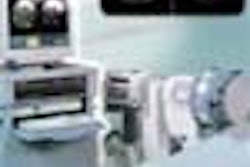NEW ORLEANS - The turf war over who should perform peripheral vascular interventions apparently strikes deep enough to keep all sides -- interventional radiologists, vascular surgeons, and interventional cardiologists -- from working together for the benefit of patients.
Dr. Peter Berger, a clinical investigator at the Mayo Clinic in Rochester, MN, moderated a panel titled "Who Should Perform Peripheral Vascular Intervention?" at the American Heart Association conference this week. He started off the discussion by asking if the dueling doctors who repair blocked blood vessels in the heart, kidney, legs, and elsewhere could work together, developing a team approach for treating a patient.
"What you are suggesting is the ideal, but the reality is that there is little cooperation in medicine," said Dr. Michael Bettman, professor of radiology at Dartmouth University Medical School in Hanover, NH.
"That's a bit Pollyannaish," replied Dr. Chris White, chairman of the department of cardiology at the Ochsner Clinic in New Orleans.
Bettman, White, and Dr. Edward Diethrich, a vascular surgeon at the Arizona Heart Institute in Phoenix, each presented arguments as to why their particular specialty should perform peripheral vascular interventions.
Bettman, an interventional radiologist, suggested that specialty wasn't the most important factor in performing the operation, but rather the doctor’s experience, expertise, and judgment. For example, when a radiologist is performing an intervention, he or she might come across a lesion in a peripheral or iliac artery and will be best able to judge whether the patient will gain anything from additional treatment, he said.
"Just because you can do something about it, doesn't mean you should," Bettman said. "If you see that type of lesion, it doesn't mean you should do anything, because it doesn't mean it is going to benefit the patient."
Interventional radiologists are also better suited assess how thrombolytic agents work in peripheral arteries as compared to the coronary arteries, as well as differences in the mechanism of plaque rupture in the periphery. And cardiologists may be unfamiliar with how to use CO2 contrast agents in the peripheral arteries in order to obtain better images, he said.
When it comes to renal intervention, Bettman again emphasized that it's not a question of who should do it, but rather of what interventionalists should know in order to perform the procedure safely and successfully.
Bettman said studies showed that the outcome of renal artery revascularization were about the same for angioplasty or angioplasty plus a stent -- but the cost was substantially higher because of the stent. Cardiologists use stents almost exclusively to prop open coronary arteries, Bettman pointed out.
"I don't pretend that only [interventional] radiologists should or can do [peripheral vascular interventions]" Bettman said. "The bottom line is that only those with real training should be the ones who do them."
In a counter-argument, Diethrich said that because the vasculature of kidneys, legs, and other organs is different than that of coronary arteries, interventionalists should leave those areas to vascular surgeons. To do otherwise can result in horrendous complications, he said.
"The vascular surgeon should, and must perform these types of surgeries," he said. "It is the only specialty providing formal training in all aspects of peripheral vascular disease, including anatomy, physiology, and arteriographic interpretation."
He said the view that any interventionalist can perform simple procedures is " treacherous -- because there are no simple procedures." It's doubtful that an interventional cardiologist or radiologist would know enough about access to certain peripheral arteries to perform successful procedures without creating serious complications -- complications the vascular surgeon then has to clean up, he said.
Interventional cardiologist White didn't want to exclude anyone from doing the procedures, provided they were qualified, but said that there are many times when cardiologists have the ability and skills to correct peripheral problems.
For example, an interventional cardiologist performing a procedure in the coronary arteries might become aware of a serious problem in the iliac or renal artery. If he already has the catheter in place, the patient sedated, and the angiogram in front of him, he is in a good position to fix problems as they come up, White said.
The group agreed that training guidelines were sufficient for doctors within the specialties to gain enough experience to perform the peripheral procedures.
By Edward SusmanAuntMinnie.com contributing writer
November 17, 2000
Copyright © 2000 AuntMinnie.com

















